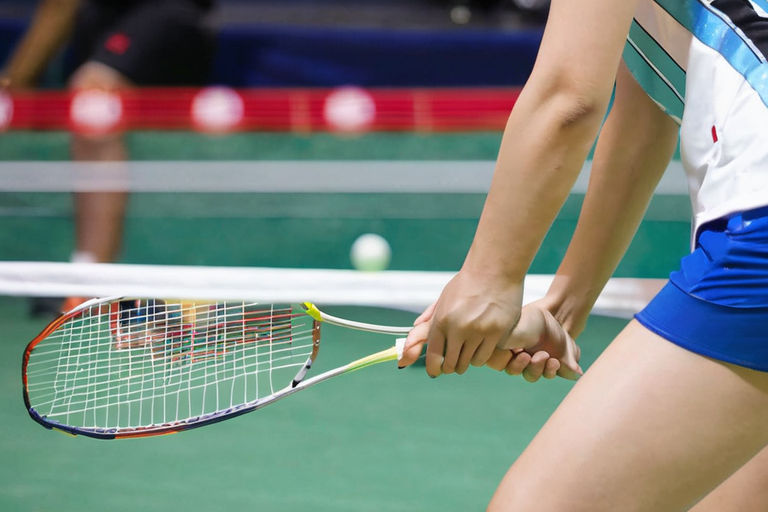
Mastering the Grip: How to Properly Hold a Badminton Racket
The fast-paced, dynamic sport of badminton demands ability, flexibility, and perfection. Gaining proficiency with the racket grip is essential to being a good badminton player. Your whole performance on the court, including control and power, can be greatly influenced by the way you hold your racket. We will examine the subtleties of badminton racket holding in this in-depth guide to help you improve.
The Grip:
The base of your badminton technique is your grip. In badminton, there are three primary grip types: the backhand grip, the forehand grip, and the panhandle grip.
Forehand Grip:
- With your non-dominant hand, hold the racket handle, making sure the third bevel of the handle is where your index finger’s base knuckle is.
- Wrap the handle with your fingers, pressing your thumb on the back surface.
- When using the forehand side of your body to execute precise and forceful shots, the forehand grip is the best option.
- Adjust the racket face’s angle for best results when making overhead strokes.
Backhand Grip:
- To execute the backhand grip, lower your hand to the handle’s second bevel and place your index finger’s base knuckle on it.
- Grip the handle with your fingers, just as you would forehand, pressing your thumb on the rear surface.
- When making strokes with the backhand side of the body, the backhand grip is essential.
- To gain more versatility, try other grip configurations, such as the V-shaped grip.
Panhandle Grip:
- When serving, the panhandle grip is utilized, and it’s especially helpful for managing the shuttle when it’s close to the net.
- Hold the racket handle with the thumb lying against the back surface, just like you would while shaking hands.
- In close net play scenarios, this grip enables improved control and accuracy.
- Develop the skill to quickly swap between grips for sneaky shots.
Understanding Grip Pressure:
Keeping the proper grip pressure throughout a badminton game is important for success. While holding the racket too loosely can result in a loss of control, holding it too tightly can cause weariness and stiffness in your shots.
Firm yet Relaxed Grip:
- Maintain a strong hold on the racket while keeping your fingers and hand relaxed.
- Tighten the grip just before impact and then release it thereafter.
- The swing can be more controlled and smoother with this method.
- Understand the dynamics of grip pressure and modify it according to the demands of the shot.
Hand Positioning:
Proper hand placement enhances the grip and helps create a more efficient playing technique.
Symmetry in Hand Position:
- Make sure that when you grip the racket, both hands are symmetrical.
- Maintaining a steady hand position facilitates smooth and accurate shot executaion.
- Examine your hand placement on a regular basis to adjust to various shots and playing circumstances.
Quick Adjustment:
- Know that your grip and hand position will change according on the kind of shot you are playing.
- Being quick to adjust can help you become a more versatile player and improve your game overall.
Finger Placement and Control:
Consider the function of each finger in your hand. In particular, the index finger is essential for managing the racket head.
Fine-Tuning Finger Placement:
- Try out various thumb and finger locations to choose a forceful yet comfortable grip that works for your playing style.
- Vary your finger location for different shots; for example, use the knuckle for extra power or the index finger pad for delicacy.
Adapting to Playing Style:
Grip technique changes may be necessary depending on the type of playing. While doubles players may place more emphasis on accurate placement and fast reactions, singles players may stress power and speed.
Customizing Your Grip for Playing Style:
- Examine your playing technique and make minor corrections to your hand and grip placement to enhance your advantages and minimize your drawbacks.
- Play around with different backhand grip configurations and modify your grip to meet the needs of your chosen playing style.
Regular Hand and Wrist Exercises:
Maintaining a solid grip and regularly making powerful shots requires strengthening the hand and wrist muscles.
Incorporate Hand and Wrist Exercises:
- Throughout practice sessions, check that your grip pressure is still dynamic and responsive to the demands of different shots.
- To increase endurance and prevent accidents, strengthen the relevant muscles with focused hand and wrist workouts.
The journey to becoming an expert holding a badminton racket is one of constant improvement and adjustment. A well-rounded and efficient grip technique will be aided by consistent self-evaluation, experimentation, and a dedication to strengthening the required muscles. As you refine your techniques, keep in mind that the secret to success is not just mastery of the technical elements but also the capacity to modify your grip in response to the dynamic character of the game. Maintain your agility, practice, and watch your badminton skills soar.